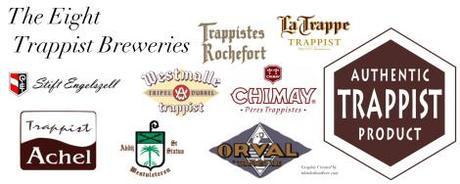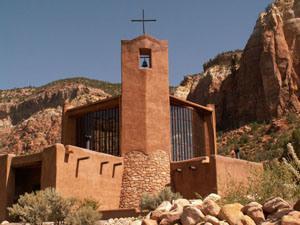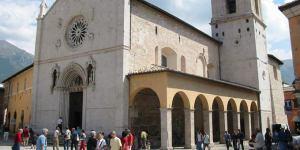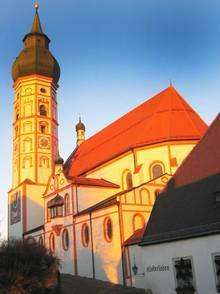 In the first 3 parts of the The Brewing Monks, we looked specifically at the history of the Trappist order and the current Trappist Breweries. In the first part, The Brewing Monks: A Brief History of the Trappist Order and Monastic Brewing, I looked at the history of the Trappist order and how abbeys become involved in brewing. In the Second Part, The Brewing Monks: The Eight Trappist Breweries (Part 1), I delved into the history of Rochefort, Stift Engelszell, Westmalle, and Westvleteren. In the third part, The Brewing Monks: The Eight Trappist Breweries (Part 2), I covered the history of Chimay, Orval, La Trappe, and Achel. The next section, The Brewing Monks: Almost Trappist, detailed some news about a few Trappist monasteries that are in the process of becoming full-fledged Authentic Trappist Product (ATP) breweries and a few that are producing beer but don’t qualify to use the ATP label. The next part will dive into the world of the other Monastic Breweries; the ones that belong to different monastic orders than the Trappists.
In the first 3 parts of the The Brewing Monks, we looked specifically at the history of the Trappist order and the current Trappist Breweries. In the first part, The Brewing Monks: A Brief History of the Trappist Order and Monastic Brewing, I looked at the history of the Trappist order and how abbeys become involved in brewing. In the Second Part, The Brewing Monks: The Eight Trappist Breweries (Part 1), I delved into the history of Rochefort, Stift Engelszell, Westmalle, and Westvleteren. In the third part, The Brewing Monks: The Eight Trappist Breweries (Part 2), I covered the history of Chimay, Orval, La Trappe, and Achel. The next section, The Brewing Monks: Almost Trappist, detailed some news about a few Trappist monasteries that are in the process of becoming full-fledged Authentic Trappist Product (ATP) breweries and a few that are producing beer but don’t qualify to use the ATP label. The next part will dive into the world of the other Monastic Breweries; the ones that belong to different monastic orders than the Trappists.
Benedictine Breweries
The Trappists aren’t the only monasteries in the world brewing beer. They’re just the most famous and well-organized. In fact, a lot of monasteries brew beer on a “homebrewing” scale for their own uses. It would be impossible to catalog all of them, especially since abbeys are private places that tend to keep their information to themselves. This sense of privacy and withdrawal from the world also tends to make it hard to find information even on the few monasteries that do sell their beer on a commercial-scale. While I don’t claim this is as an exhaustive list of every commercially producing monastery, it is pretty thorough. If I’ve missed one you know about, please feel free to post what you know in the comments and I’ll research it and add it in an update.
The Monastery of Christ in the Desert – Abiquiu, New Mexico (Est. 1964, Brewery Est. 2005)

(Picture from http://www.christdesert.org)
The monks of Christ in the Desert belong to the Benedictine Order, the order from which the Trappists and Cistercians originated. The monastery was founded in 1964 with monks from Mount Saviour Monastery in New York. They became an autonomous abbey in 1996. Currently, they have 3 dependent monasteries, two in Mexico and one in Chicago, that rely on the monks of Christ in the Desert for direction and aid. Like many monasteries around the world, Christ in the Desert seeks to take advantage of sustainable practices and green living. In their case, they operate solar panels to take advantage of the desert sun.
In 2005, the monks decided to add to their industries by adding a small brewery. Although they are brewing some beers in-house, the majority are brewed at Sierra Blanca Brewing near Albuquerque with hands-on help from the monks. Additionally, the monks own part of the brewing equipment. The monks control all aspects of their beer including recipes, material acquisition, and marketing. They’re also brewing select beers with a local subspecies of hops grown on their land known as “neomexicanus.” The beers are marketed under the Abbey Beverage Company name, a separate company the monks setup to facilitate the marketing of their beers. Their beers can be found throughout the South West and in select Mid-Atlantic states. They brew the following beers:
- Monks’ Ale
- Monks’ Wit
- Monks’ Dubbel
- Monk’s Dubbel Reserve
- Monks’ Tripel Ale
- Monks’ Tripel Reserve Ale
The Monastery of San Benedetto – Norcia, Italy (Est. 1998, Brewery Est. 2012)

(Picture from http://www.obsnorcia.org)
Norcia, Italy was the birthplace of St. Benedict in the 480 CE. The current Monastery of San Benedetto was founded during the 10th century and was continually occupied until the monks were forced to flee from the forces of Napoleon in 1810. It wasn’t until 1998 when Father Cassian got the idea to found a new Benedictine monastery that Norcia would once again host monks paying homage to the city’s famous historical citizen. Starting in what amounted to an apartment in Rome, the monks were offered a place of their own in the abandoned abbey located near the birthplace of their founder, St. Benedict. The monastery quickly grew and is now nearly full. The monks are now in the process of renovating a nearby 16th century former Capuchin monastery.
To further this goal, they need additional funding for the estimated 6 million Euro project and thus have started a brewery to add to their business enterprises. The beer, Birra Nursia, is only available for purchase in the local area at this time and is brewed in tiny batches. The beers are brewed entirely by the monks in their abbey. Taking inspiration from their more famous brewing cousins in Belgium, they brew two Belgian inspired beers. The Blond is a light, refreshing ale while the Extra is a richer, more complex beer.
The Abbey of St. Boniface (Kloster Andechs) – Andechs, Germany (Est. 1455, Brewery Est. 1455?)

The pilgrimage church at Kloster Andechs (Picture from http://www.andechs.de)
The site of Kloster Andechs has long been a holy site starting in the 10th century when the Count of Andechs-Merenia traveled to the Holy Land and returned with relics. The church quickly became a pilgrimage site and lasted until the Count’s descendents were defeated and died out. The relics were lost for a while until, as legend has it, someone saw a mouse dragging one of the relics around. The site was excavated in the 14th Century and the relics rediscovered. The new rulers of what was called the Holy Mountain began raising funds at the end of the 14th century until enough funds were raised to found a Benedictine monastery on top of the mountain in 1455.
Over the next 350 years, the fortunes of the abbey waxed and waned with reformation and 30 Years war until, like many European monasteries, they were forced to close in 1803 during the Napoleonic wars. The lands and buildings were sold off and secularized. A short 47 years later, King Ludwig I purchased the former Andechs abbey and lands in order to give them to the Benedictine monastery of St. Boniface of Munich. Since then, they have functioned as sister abbeys. The brewery, like at many brewing abbeys, provides the main income. Andechs brews over 100,000 hectolitres of beer a year (85,225 bbls). Their beer lineup includes:
- Dunkel Doppelbock
- Export Dunkel
- Bergbock Hell
- Spezial Hell
- Vollbier Hell
- Weissbier Hell
- Weissbier Dunkel
Kloster Andechs is imported into the US by S & H Brands.
Benedictine Abbey of Weltenburg (Kloster Weltenburger) - Weltenburg, Germany (Est. 617, Brewery Est. 1050)

(Picture from http://www.weltenburger.de)
The first monastery at Weltenburg was established by Scottish monks, who followed the monastic rules of St. Columba, in approximately 617. By 800, the abbey had adopted the rules of St. Benedict and has been a Benedictine Monastery ever since. The history of Weltenburg Abbey is similar to that of most of the other Abbeys of Europe. They’ve suffered through various wars, invasions, Protestant-Catholic wars, to finally be shut down during the Napoleonic secularization of 1803. Like Kloster Andechs, they were repopulated with monks in 1858. Weltenburg returned to the status of a full, independent Abbey in 1913.
Kloster Weltenburger boasts one of the longest continuous brewing histories, second only to Weihenstephaner which was founded in 1040. Because of the bucolic location in the mountains and next to a river, their beer garden is a classic tourist destination where travelers go to drink the monks’ excellent beer. Their current lineup consists of:
- Pils
- Hefe-Weisbier Hell
- Hefe-Weisbier Dunkel
- Weisebier Alkoholfrei
- Urtyp Hell
- Barock Hell
- Anno 1050 (A maertzen)
- Asam Bock
- Barock Dunkel
- Winter-Traum
Kloster Weltenburger is imported into the US by S & H Brands.
Ampleforth Abbey - York, England (Est. 1802, No Brewery Yet)

(Picture from http://www.ampleforth.org.uk/)
Ampleforth’s modern history dates to 1792 when Benedictine monks fled from Revolutionary France and settled in North England. However, these same monks could trace their origins to pre-Reformation England, where the Benedictines enjoyed a lot of success until Henry VIII closed down the Monasteries. The final blow, after a brief Catholic reprieve under Queen Mary, happened when Elizabeth I finalized her father’s Reformation works. The English monks fled to Catholic France where they’d be relatively safe for nearly 200 years.
Currently, Ampleforth houses around 70 monks and operates a school, hosts retreats and runs a sports center. The monastery had been making cider, keeping bees, and making cheese cake as part of their works. They decided to add a beer to lineup and sought help from a Dutch brewer on what kind of beer they should produce. Currently, they’re not brewing the beer on site, but will eventually install a brewhouse next to their cider making facility. The beer is brewed at small, local brewery called Little Valley Brewery. The beer is a Belgian-style Abbey Dubbel, an amber beer of 7% ABV.
Ampleforth Abbey is currently not imported into the United States.
Resources/References Great Beers of Belgium by Michael Jackson, (Brewers Publications, 2008)
brew like a monk by Stan Hieronymus, (Brewers Publications, 2005)
The Oxford Companion to Beer edited by Garret Oliver, (Oxford University Press, 2012)
http://en.wikipedia.org/wiki/Trappist_order
http://en.wikipedia.org/wiki/Cistercian_order
http://www.trappist.be/en/pages/the-international-trappist-association

